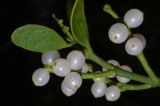ASRM2010: Hormonal therapy or mistletoe?
Denver, 26 October 2010
1530 abstracts were submitted to this year’s annual meeting of the ASRM. Of these, 916 were accepted; nine of those were oral presentations about endometriosis (out of 316 orals), and 27 (out of 600) were poster presentations. We have chosen to highlight two of the chosen papers on endometriosis.
A year of hormonal therapy shrinks rectovaginal endometriotic nodules
 Dr Ferrero et al, from the San Martino Hospital and University of Genoa in Italy, found in a prospective study that several different hormonal therapies administered for one year were effective in decreasing the volume, by approximately 24%, of endometriotic nodules infiltrating the rectum in 41 of 46 patients enrolled in the study.
Dr Ferrero et al, from the San Martino Hospital and University of Genoa in Italy, found in a prospective study that several different hormonal therapies administered for one year were effective in decreasing the volume, by approximately 24%, of endometriotic nodules infiltrating the rectum in 41 of 46 patients enrolled in the study.
The patients’ nodules were measured by virtual organ computer-aided analysis at the study’s baseline and were compared to measurements taken at six and 12 months after horomonal therapy was started. Each patient received one of five hormonal therapies.
At the beginning of the study, the average endometriotics nodules’ volume was 4.3cm. After six months of treatment, nodule volume in patient groups receiving norethisterone acetate, triptorelin and tibolone, and norethisterone acetate and letrozole was reduced.
For women taking oral contraceptives or desogestrel, there was no reduction in nodule size after six months. However, after 12 months of treatment, the nodule volume was significantly decreased, by an average of 24%, for all treatment groups, with no significant difference in the reduction of nodule volume according to the type of hormonal treatment.
Mistletoe inhibits the growth of endometrial cells in culture and holds promise as a possible future treatment
 In a prospective study Dr Moon, from the Seoul National University in Korea, investigated the anti-angiogenic effect of mistletoe, an immune modulator, on women with endometriosis.
In a prospective study Dr Moon, from the Seoul National University in Korea, investigated the anti-angiogenic effect of mistletoe, an immune modulator, on women with endometriosis.
From June 2007 to January 2009, 40 women between the ages of 25 and 50 were enrolled in the study. Twenty women, who had recently had gynaecologic surgery for benign conditions were enrolled as controls.
For each study subject, endometrial tissue was collected from both the inside and the outside of the uterus. The tissues were cultured. Then, endometrial stromal cells were removed and cultured with peritoneal fluids from the subject or from a control, with or without mistletoe supplementation.
The endometrial stromal cells grew more robustly in the subject’s peritoneal fluid (PF) than in PF from a control. However, when mistletoe was added to the subject’s PF, cell growth was suppressed below the level of cell growth in control PF not supplemented with mistletoe.
The authors conclude that mistletoe may have anti-angiogenic effects that would make it a good candidate for further investigation as a potential treatment for endometriosis.

ASRM President Elect, Rogerio Lobo MD
ASRM President Elect, Rogerio Lobo, noted that:
“endometriosis is a life-disrupting disease, often very painful and detrimental to fertility. It is a challenge to find the best method to treat it; these studies show the importance of both refining our knowledge of existing treatments and searching out new possibilities”.
To stay up-to-date with news in endometriosis, follow us: twitter.com/endometriosis






